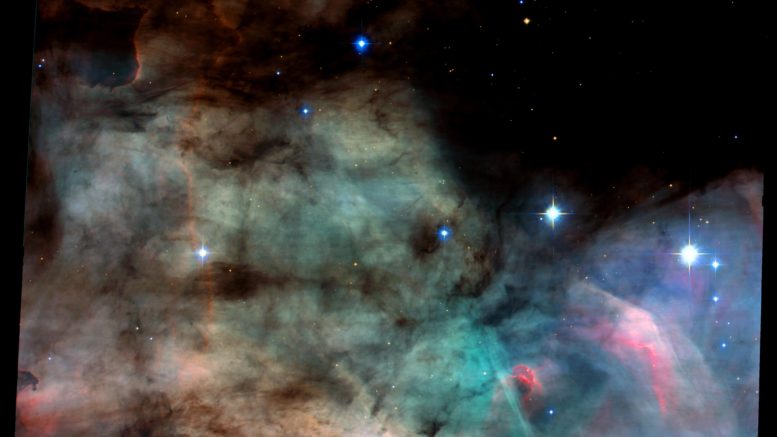Messier 17 is the star-forming nebula that is more famously known by its nicknames as the Omega Nebula, Swan Nebula, Checkmark Nebula, or Horseshoe Nebula. Located in the Sagittarius constellation, M17 is a very beautiful nebula that is one of the most massive star-forming regions in our galaxy.
| Description | |
| Visible From Pacific Northwest | April to September |
| Best Time To Observe | August |
| Minimum Size Of Viewing Device | Binoculars |
| Object Type | Emission Nebula |
| Designations | Omega Nebula, Messier 17, M17, NGC 6618, Sharpless 45, RCW 160, Gum 81, Collinder 377, LBN 60, Swan Nebula, Lobster Nebula, Horseshoe Nebula, Checkmark Nebula |
| Right Ascension | 18h 20m 26s |
| Declination | -16°10’36” |
| Constellation | Sagittarius |
| Absolute magnitude | 1.001 million years |
| Apparent magnitude | +6.0 |
| Apparent dimensions | 11′ |
| Object Radius | 11 light years |
| Distance From Earth | 5,000 to 6,000 light years |
History
The Omega Nebula was first discovered by Philippe Loys de Cheseaux in 1745.
Charles Messier independently discovered the nebula on June 3, 1764.
The first attempt to accurately draw the nebula was made by John Herschel in 1833, and published in 1836. This is important because its is from John Herschel that the name Omega Nebula comes from when he said,
The figure of this nebula is nearly that of a Greek capital omega, Ω, somewhat distorted, and very unequally bright. … Messier perceived only the bright eastern branch of the nebula now in question, without any of the attached convolutions which were first noticed by my father. The chief peculiarities which I have observed in it are — 1. The resolvable knot in the eastern portion of the bright branch, which is, in a considerable degree, insulated from the surrounding nebula; strongly suggesting the idea of an absorption of the nebulous matter; and, 2. The much feebler and smaller knot at the northwestern end of the same branch, where the nebula makes a sudden bend at an acute angle.
John Heschel
Locating M17 In The Sky
Messier 17 is relatively easy to locate using the stars of the Teapot in Sagittarius. An imaginary line drawn from Kaus Australis past just to the left of Kaus Media to the north leads directly to M16 and M17.
The Omega Nebula lies just to the south of the Eagle Nebula. Two other famous nebulae – the Trifid Nebula (Messier 20) and the Lagoon Nebula (Messier 8) are located in the same part of the sky.

Viewing M17
The Omega Nebula is just on the limit of naked eye detection in good conditions, with clear, dark skies and no light pollution. It is best observed in low-powered telescopes and binoculars. It lies in the same binocular field of view as Messier 16 and Messier 18, a faint open cluster in Sagittarius.
Photographing M17
The nebula can be imaged with a non-modified DSLR, as well as other imaging technology. The non modified DSLR will not provide as much detail, but with enough images, it is indeed possible to obtain a great photo! Using several 3 minute photos with ISO 1600, is how some have been able to image M17 using a DSLR. If using a refractor, make sure to use either a UV or an IR filter to help make sure tthat only the desired light gets in.
Sources And Further Reading
Descriptions of all of Messier Objects can be found here.
https://www.nasa.gov/feature/goddard/2017/messier-17-the-omega-nebula-or-swan-nebula/

Really enjoyed this blog. Thanks Again. Keep writing. Jemie Jervis Karolyn
I was reading some of your articles on this website and I think this website is real informative! Continue putting up amazing content!
Greate article. Keep writing such kind of info on your blog.
I really like the design and contents of your web page
You produce quality content, I appreciate you
I must say I read a great article with pleasure
Thanks for a marvelous posting! I truly enjoyed reading it, you are a great author.
I will remember to bookmark your blog and will eventually come back later in life.
I want to encourage you to ultimately continue your great
work, have a nice day!
Thank you for this beautiful article. It’s really a good article!
I want to to thank you for this very good read!! I absolutely loved every little bit of it. Thanks for the share!